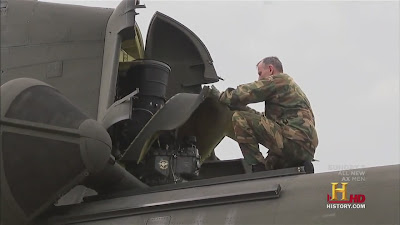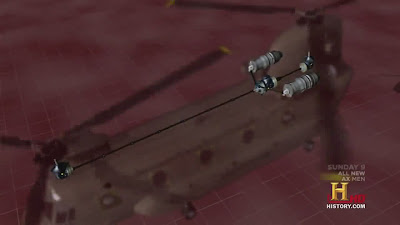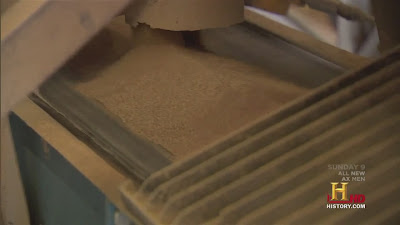
Due to the organic particles (Walnut Grit) clogged in the oil lubrication system causing
the transmission failed. The photos captured from Modern Marvels : Engineering Disasters.










On Sept. 11, 1982, a CH-47 Chinook helicopter from the Coleman Barracks-based 295th Assault Support Helicopter Company was carrying skydivers from France, Germany and Wales when it plummeted 600 feet to the ground during an air show marking Mannheim’s 375th anniversary.
A Chinook’s front and rear rotor blades are synchronized to rotate together, without the blades hitting. Investigators later determined that parts on the front rotor failed, causing a desynchronization of the two rotors, according to a report published on the Internet. The rear rotor and its support structure were torn from the helicopter, causing it to fall, the report said.

The CH-47 Chinook helicopter is equipped with two engines, the engines are connected to
the combing transmission, the engines through the combining transmission to rotate
driveshaft that controlled the synchronization rotation of the rotors.



This allows the rotor blades pass by each other without making contact.








Failure of the Input Pinion Capsule was caused by Walnut Grit blocking the oil journals
inside the transmission. Walnut Grit was used to clean the transmission during the overhaul process.
The failure of the Input Pinion Capsule was caused by walnut grit blocking the lubricating
oil journals inside the transmission.For many years prior to this accident, walnut grit was successfully used as an effective cleaning agent for the transmissions during the overhaul process. It is softer than the base metal, but harder than the contaminants that accrue
inside the transmission.
Shortly prior to this accident a procedural change in the process was made. Inspectors working for the Occupational Safety and Health Administration (OSHA) examined the
working conditions at Corpus Christi Army Depot. It was noted that high pressure air, approximately 3,000 PSI, was used to blow the walnut grit out of the oil journals. This high
a pressure was deemed dangerous to workers and it was ordered that the pressure be lowered. As a result, the walnut grit was no longer completely removed during the
cleaning procedure. Eventually, when the transmission was placed into service, the walnut grit
would flow through the oil passages and accumulate in a point blocking a journal. A bearing
would fail from the lack of lubrication.




sandblaster.

Walnut Grit.


causing the shaft to fail, followed by the subsequent de-synchronization of the Forward
and Aft Rotor Systems.
The Forward and Aft Rotor Blades meshed causing the Aft Pylon, Aft Transmission and
the Aft Rotor System to separate from the helicopter with catastrophic results. The entire
crew and all passengers received fatal injuries.
Whether or not the preceding paragraph was entirely true is not clear. What was known was that walnut grit did indeed block the oil journals and cause the failure of the Input Pinon Capsule. Flight Engineers serving in the Army from that time period reported that this
accident resulted in a fleet wide grounding and inspection of all transmissions. They went
on to report that most of the operational fleet contained walnut grit in many of the
transmissions.
For more information : The Crash of Boeing CH-47C Chinook 74-22292


I had a friend killed in Viet Nam when he ignored his transmission oil pressure gauge reading zero in his UH1-H. The temp gauge needed oil flow passing over the sensor to tell him it was overheating. (No oil flow, no high temp. reading.)
ReplyDeleteThe tranny seized, killing 11 combat-ready troops.
I wonder if these pilots similarly ignored a warning?
I don't think so. I knew both pilots. They knew something was wrong so they aborted the parachute jump. They had 42 sport parachuters on bord along with the four crew. They were making an emergency desent when it came part.
DeleteThe Army had had two similar accidents on the ground but they were searching their heads and let the Chinook fleet fly. Normally when they have two accidents that they do not know the cause, they ground the fleet, but this time they did not and 46 people died. When you withhold information from people, you have LIED to them and the Army LIED!
Oh, I flew Hueys in Vietnam too. And I had a wildly fluctuating transmission oil pressure on the aft tyranny on a Chinook. This was about a year after the crash of the one above. Anyway we landed and had the maintenance team come in. They recovered the aircarft and a few days later they got the results from the oil sample. It recommended that the aircraft NOT be flown until after that transmission had been replaced. But that was about a year after the one above.
There were two similar Chinook accidents in 1966 and had more attention been paid to the recommendations this crash could have been avoided.
DeleteThis comment has been removed by the author.
DeleteMy maintenance instructor knew those guys. He said the oil pressure gauge fluctuated a couple of times but this was a high profile mission. Lots of generals and spectators were expecting a big show. I was a CH-47 maintenance mechanic.
DeleteThis is an interesting, detailed account of a crash.
ReplyDeleteI am writing a memoir to honor veterans of the vietnam war. I need a picture of a CH-47 to support my description of a crash in Vietnam.
I would like permission to use the first picture posted here:
http://maybach300c.blogspot.com/2012/08/ch-47-crash-in-mannheim.html
Can you tell me the source (owner) of this picture?
The photos captured from Modern Marvels : Engineering Disasters.
Delete(History Channel).
I did not own these pictures, so free to use.
ReplyDeleteHi there, awesome site. I thought the topics you posted on were very interesting. I tried to add your RSS to my feed reader and it a few. take a look at it, hopefully I can add you and follow.
SensualKart Flavoured Lubricant
I was there as an MP stationed in Mannheim, FRG. We were tasked with providing security for the accident. To this day I can't forget what I saw in the aftermath.
ReplyDeletein was also there that day. my pops was the chief of reforger at the time, we got there late (there has been an accident not too far away with a tank rolling over a car earlier in the day). we have our own pictures of it that i found while going through his storage until this past weekend
DeleteHi, I was a child during this; just an Army Brat - I remember bits and pieces and have a few pictures to share if anyone is putting together anything. They're very inconsequential, but if they are helpful I'm happy to send them on.
ReplyDelete